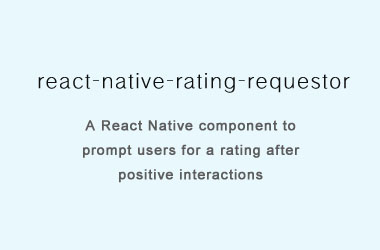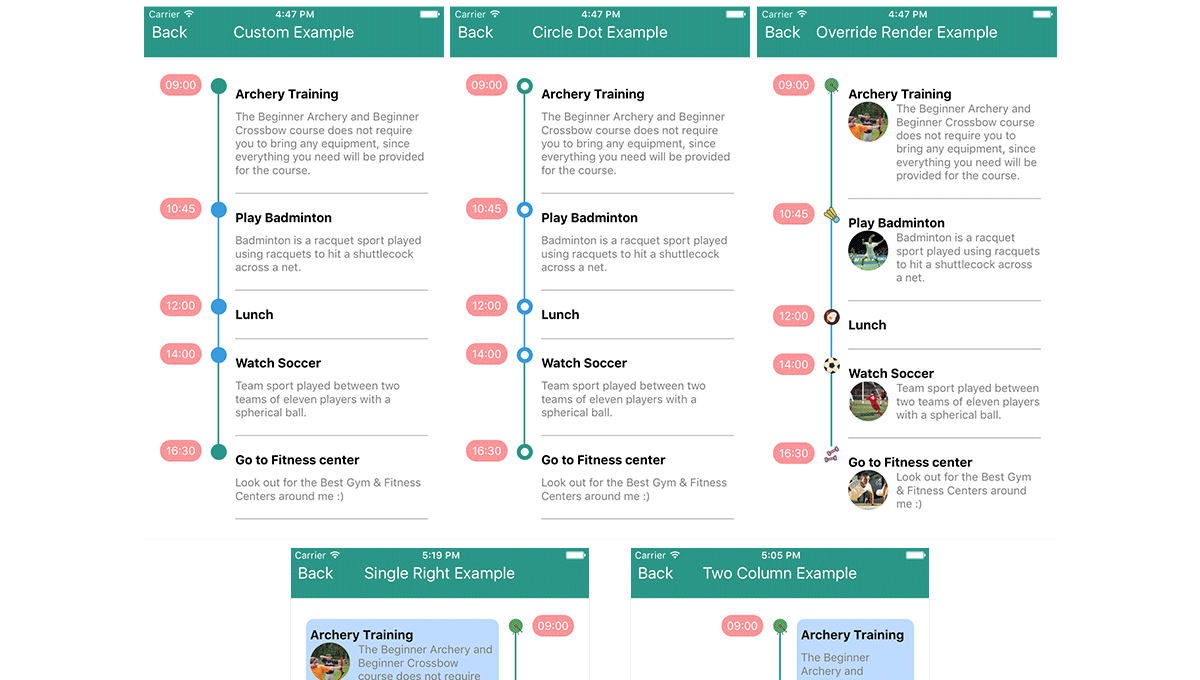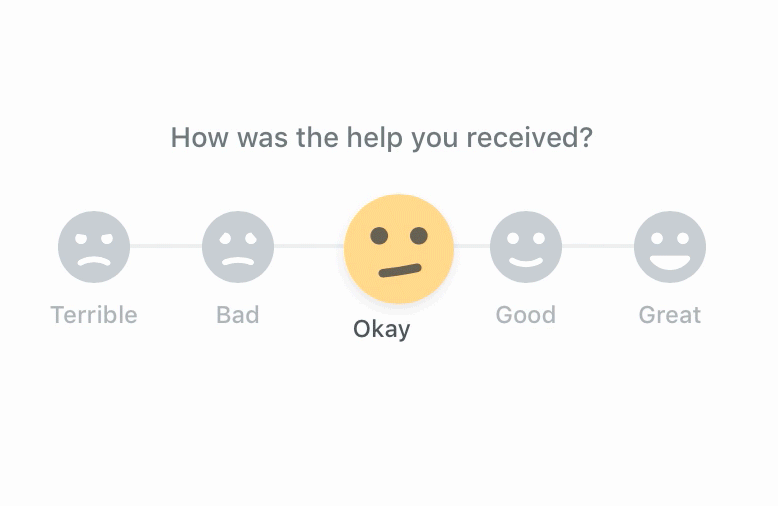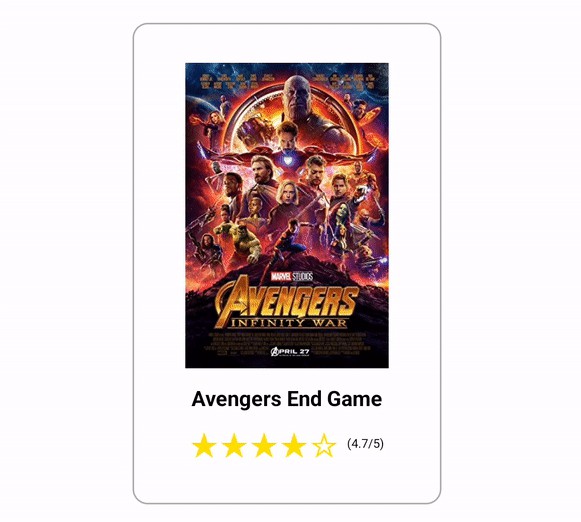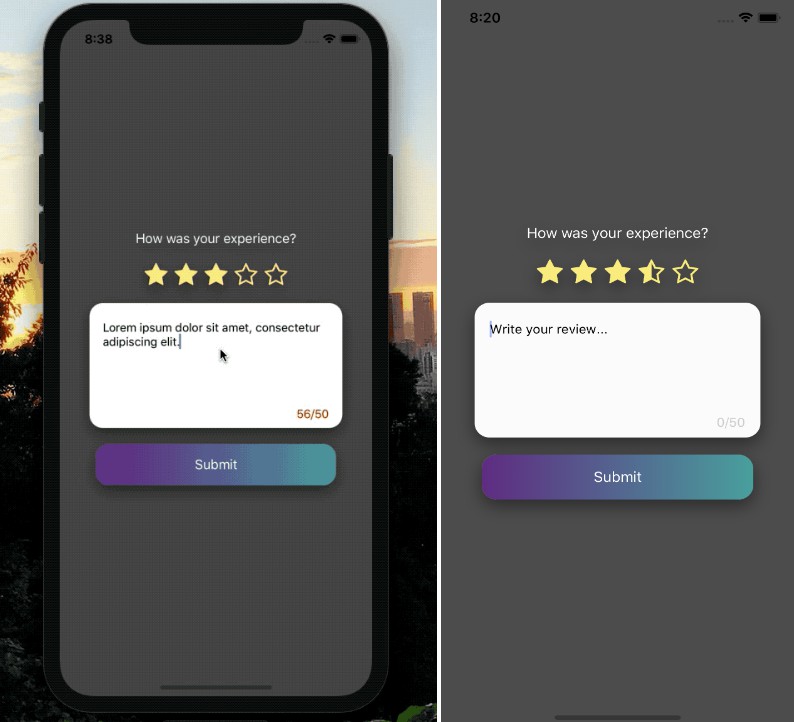react-native-rating-requestor
A React Native component to prompt users for a rating after positive interactions
The Rating Requestor is a very simple JS module that you simply instantiate and call from time to time, as your user performs actions that result in a "happy path." For example, maybe your users get a smile on their face every time they save money with your app, beat a level, or clear out their inbox. After a certain number of these positive events, it might be a good time to ask the user for a review.
Installation
npm i --save react-native-rating-requestor
Usage
Import and create a new instantiation of the Rating Requestor somewhere in the main portion of your application:
import RatingRequestor from 'react-native-rating-requestor';
let RatingTracker = new RatingRequestor('[your apps store ID]');
let MyApp = React.createClass({ ... });
When a positive UX event occurs, let the Rating Requestor know so that it can keep track of these:
if (user_saved_the_world) {
RatingTracker.handlePositiveEvent();
}
The example above is used without callback. A callback can be provided that reports on result of the handling. The callback accepts two parameters: the first indicates whether the request dialog appeared (boolean), and the second returns the user decision (string: 'decline', 'delay', or 'accept').
if (user_saved_the_world) {
RatingTracker.handlePositiveEvent(function(didAppear, userDecision) {
if (didAppear) {
switch(userDecision)
{
case 'decline': console.log('User declined to rate'); break;
case 'delay' : console.log('User delayed rating, will be asked later'); break;
case 'accept' : console.log('User accepted invitation to rate, redirected to app store'); break;
}
} else {
console.log('Request popup did not pop up. May appear on future positive events.');
}
});
}
If enough positive events have occurred (defined by the timingFunction) then a rating dialog will pop up. The user can rate the app or decline to rate, in which case they won't be bothered again, or can choose to maybe do so later, in which case the Rating Requestor will keep on tracking positive event counts.
You can also trigger the rating dialog to appear immediately by invoking RatingTracker.showRatingDialog([callback]). If you have a "Rate this App" button or link in an about page or something in your app, this would be a good place to use that.
Configuration
All configuration occurs on the construction of a new RatingRequestor.
let myRR = new RatingRequestor(appStoreId, [ options ]);
You must pass in a string as the first parameter, which is the app store ID of your application. Optionally, but highly suggested, is a second parameter: a set of options to customize the request dialog and the timing of the dialog. This object follows this pattern:
{
title: {string},
message: {string},
actionLabels: {
decline: {string},
delay: {string},
accept: {string}
},
buttonOrder: {
ios: [buttonTypes],
android: [buttonTypes],
},
shouldBoldLastButton: {boolean},
storeAppName: {string},
storeCountry: {string},
timingFunction: {func(currentCount) => boolean}
}
title: A string used as the title for the dialog (e.g., "Please rate me!")message: The message you'd like to show the user (e.g., "If you are loving [my app's name], would you please leave me a positive review?")actionLabels: An object with three properties (all required if you don't want weird blanks or OKs):decline: The "no thanks, I don't want to ever rate this" button labeldelay: The "maybe I'll rate this later if I'm feeling charitable" button labelaccept: The "oh my gosh I love this app so much so I'll rate it right now" button label
buttonOrder: An object with platform keys (iosandandroidor others), with the value of each key being an array of length 3 containingbuttonTypevalues, which can be imported from the package. This defines the order the buttons will appear on the dialog. The default order for both platforms is as follows:[buttonTypes.NEGATIVE_DECLINE, buttonTypes.NEUTRAL_DELAY, buttonTypes.POSITIVE_ACCEPT]
shouldBoldLastButton: If passed as true, the third button of the modal will have a more prominent style. This option currently only modifies iOS stylingstoreAppName: iOS only, the slug that Apple uses in the URL to the app listing. Anything seems to work here, including the defaultappName, but might as well make it match what Apple has, right?storeCountry: Target a specific coutry's store, defaults tous.timingFunction: A method that takes the current total count of positive events recorded for the app, and returns if the Requestor should display the dialog or not. By default, the timingFunction evaluates as3^n, and if3^n == currentCountthen it returns true/shows the dialog. Source looks like this:
timingFunction: function(currentCount) {
return currentCount > 1 && Math.log(currentCount) / Math.log(3) % 1 == 0;
}
Notes
As of version 2.0.0 this package is compatible with both iOS and Android.
